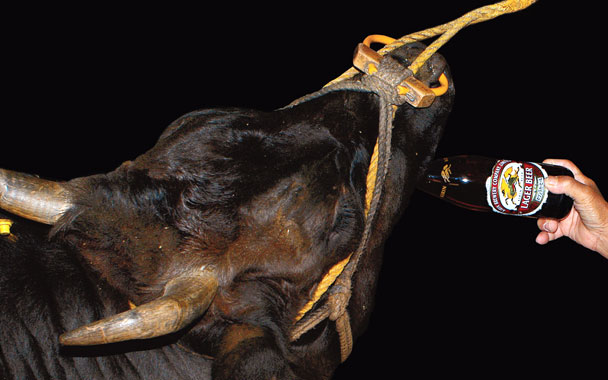I first tasted Kobe beef at the Kobe club, a sleek midtown Manhattan temple to the legendary steak. Overhead, 2,000 samurai swords hung, business ends downward, from the ceiling, while black-clad staff almost seemed to float through the darkness like shadows. Just after Jude Law and Michael Caine sat down a couple of tables over, a waiter materialized to my left and, with a flourish, presented me with a sizzling ten-ounce rib eye. There was a tiny paper Japanese flag jutting from a toothpick that had been jabbed into the $175 entrée.
I put a morsel in my mouth, and my surroundings became unimportant. A thin, salty sear on the outside crackled and then released a warm gush of what seemed like beefy, buttery pudding, as rich as foie gras. With that one bite, I understood why Kobe has become the signature dish of the decade, with sales tripling during the past five years, not only at urban trendsetters but also at virtually every self-respecting steak house in the country and even at ambitious mid-range grills, where Kobe burgers are the new luncheon item du jour.
As the meat melted in my mouth, I marveled. The night before, I’d grilled a grass-finished skirt steak. How could two cuts of beef be so utterly different, the one pale pink and requiring neither knife nor teeth, the other—from an animal that had spent its life grazing on pasture as a cow is supposed to do—tangy, chewy, and bloody?
Like many people, I am familiar with Kobe lore: These supremely pampered bovines pass their days in almost Zen-like bliss, getting regular massages and subsisting on all the grain they can eat, washed down with cold Kirin beer. “Imagine a life completely free of stress, with as much tender-loving-care you could ever want” is how the website of an American importer of Kobe beef puts it. “Sound too good to be true?”
That was an interesting question, and I wondered why I’d never thought to ask it myself. Why the massages? Why the beer? Was this science or mystical malarkey?
Getting to see Kobe beef on the hoof is anything but easy. Raymond Blanc, co-owner of the Michelin two-star Le Manoir aux Quat’ Saisons, outside Oxford, England, is one of the few Western chefs to have visited a Japanese Kobe farm. Blanc’s knowledge of meat production has its roots back in the 1950s, in rural Besançon, France. “I have a deep understanding of country life and of feeding livestock,” he said, pausing to sample a dish brought into his office by a sous-chef and issue orders for corrections. “On our farms, you have the kitchen on one side, and you just open the door and there’s the stable.”
While touring Japan in 1993, Blanc visited several major cities. As soon as he arrived in Kobe, he asked to see a beef farm. His request brought a surprisingly cool response from his hitherto accommodating Japanese hosts. “Yes, yes, yes,” they said, but it never happened. So Blanc organized his own trip to the countryside—and was shocked by what he saw.
“The animals were kept in some kind of crate, so there could be very little movement. They were very dirty from their own manure—and I know a dirty cow from a clean cow. It was disgusting, such a contradiction from what I’d read.”
Blanc’s observations were confirmed for me by knowledgeable experts. David Blackmore, an Australian cattle rancher who has visited Japanese farms and agricultural centers a dozen times over the four decades he’s been in the business, raises an internationally renowned herd of 2,000 full-blood Wagyu (pronounced “wah-gyu” or “way-gyu”) cattle north of Melbourne. Wagyu, he explained, is the breed from which Kobe meat comes, but the meat can only properly be called Kobe if it comes from a pure strain of Wagyu raised in the Hyogo prefecture, which includes the city of Kobe.
Traditional Japanese producers, Blackmore said, raise their 1,600-pound cattle in highly confined areas. “From the time they are a week old until they are three and a half years old, these steers are commonly kept in a lean-to behind someone’s house,” said Blackmore, “where they get bored and go off their feed. Their gut stops working. The best way to start their gut working again is to give them a bottle of beer.
“The steers have been lying in their own manure,” he continued. “The farmers are proud of their cattle, and the first thing they do is grab a bit of straw and rub the manure off. That could be seen as be-ing massaged. Wagyu can also get a lot of joint swelling. I can imagine that the farmers would be massaging joints so they could get the animals off to market.”
Charles Gaskins, a professor of animal science and a Wagyu expert at Washington State University—he’s also one of the directors of the American Wagyu Association—puts it somewhat less diplomatically. “The steers grow so big and heavy, they get arthritic,” he said. “It’s a matter of keeping the animals going until they are ready to be harvested.”




 Pinterest
Pinterest






